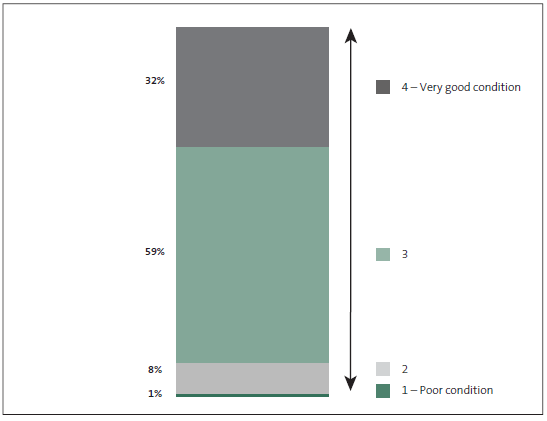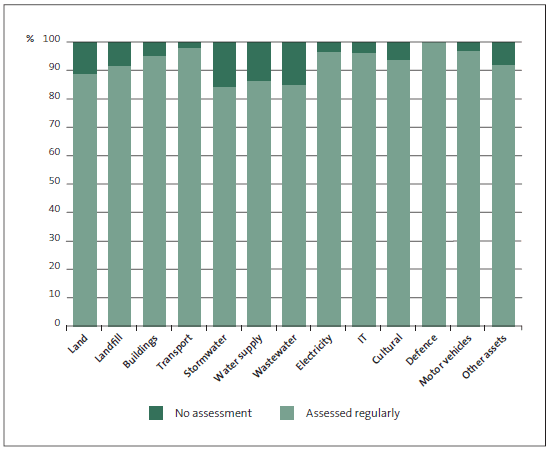Part 3: The condition of assets
3.1
In this Part, we summarise the information we collected about
Current condition of assets
3.2
Although we did not directly assess the condition of assets, the information we collected indicates that most assets are in good condition. On a scale of 1 to 4, the average condition rating was about 3.3.
Figure 4
Condition of public assets

Note: Grade 1 was defined as poor condition and grade 4 as very good condition. Grades 2 and 3 were not defined.
3.3
Health and educational assets received the lowest ratings, each with an average rating of 3.1. These lower ratings are consistent with the results of recent work by us and others in the health and education sectors.
3.4
In 2011, we completed a high-level review of how DHBs manage assets6 and found that, since 2009, when the Ministry of Health required DHBs to record their approach to asset management in asset management plans, most DHBs had not improved how they plan to manage assets.
3.5
We have followed up our findings with individual DHBs as part of our annual audits for 2011/12, and will continue to follow up with individual DHBs on aspects of their asset management planning that need to improve.7
3.6
We are carrying out a performance audit about regional service planning by DHBs. The audit considers whether regional service planning is informing capital investment and whether it is guided by high-quality information about future needs. We intend to present our report on this audit to Parliament later in 2013.
3.7
Asset management continues to be a priority for central government entities, including tertiary education institutions (TEIs), that own or manage substantial assets, mostly land and buildings.
3.8
In line with the Treasury's work on a CAM framework for the State sector, the Tertiary Education Commission (TEC) has been working collaboratively with TEIs to encourage stronger planning practices and to seek better information about TEIs' assets. As part of this work, the TEC has been creating a CAM Monitoring Framework for TEIs. This framework includes capital intentions reporting, management standards, independent reviews of asset management, and creating tools such as business case guidelines.
3.9
Because of the extent of the assets of TEIs and the service delivery capital investment taking place, asset management remains an audit focus. Although there is financial pressure on many TEIs, several TEIs plan new construction and campus developments.
3.10
Most capital development within TEIs has been focused on repairing and replacing assets, although there is a small but material amount of new construction, particularly in metropolitan centres. Campus growth and renewal is seen as necessary, not just to replace old facilities or provide for expansion, but also as a means to attract students from New Zealand and abroad.8
How often the condition of assets is assessed
3.11
The information we collected shows that assessments of the condition of assets are carried out regularly on 93% of assets by value. Figure 5 shows the percentage of assets with regular assessments, by type of asset.
Figure 5
Percentage of assets with regular condition assessments, by type of asset

3.12
Land, stormwater, water supply, wastewater, and other assets make up most of the assets that are assessed less regularly. However, we know that it can be difficult to assess the condition of some of these assets, such as underground water pipes.
3.13
Difficult-to-assess assets are often inspected during reactive maintenance, rather than through a formal programme of regular sample assessments. This can be a cost-effective way to assess the condition of such assets.
3.14
Keeping asset management plans and asset condition information up to date is important for plans to be useful. Regular updating is usually the easiest way to keep information relevant and useful.
Learning example: Greater Wellington Regional Council
3.15
One public entity faced with a challenge in updating condition information was Greater Wellington Regional Council (Greater Wellington), which recently acquired much of the train rolling stock and other assets previously owned by New Zealand Railways Corporation.
3.16
On acquisition of those assets, Greater Wellington had little or minimal information about their condition, which presented a challenge to its ability to manage the assets There were a number of risks and difficulties that Greater Wellington had to overcome.
3.17
We set out as an example how Greater Wellington approached this issue and some of the lessons learned.
| Condition assessments are important |
|---|
|
Public transport is vital to Wellington's Regional Land Transport Strategy. It helps people travel safely, easily, and efficiently throughout the region, while providing good access to properties, businesses, and other destinations. Greater Wellington provides public transport services (train, bus, and harbour ferry services) to reduce congestion and to help meet the needs of those without private transport, and considers this to be an essential service for the public good. Every year, more than 11.3 million passengers travel on the Wellington commuter rail network.* It is therefore very important to manage and maintain the network effectively. In July 2011, Greater Wellington agreed with the Government, KiwiRail, and the New Zealand Transport Agency to complete the rebuilding of Wellington's commuter rail network and transfer the ownership of the entire network, including trains and stations†, to Greater Wellington. Taking ownership of those assets gave Greater Wellington a better understanding of them than when it was paying for their use but the assets were owned by other public entities. To effectively plan and manage the maintenance, refurbishment, and replacement of assets over their lifetime requires a good understanding of their current condition. Over time, the condition information tells an important story about the assets and helps create efficiencies though highlighting areas of strength and weakness throughout a network. The rolling stock (trains) is often an area of focus. However, the railway stations are equally important in providing a safe service. Taking ownership of more than 40 railway stations presented Greater Wellington with a challenge. Without current or historical information about their condition, effective planning was not possible. Unlike new assets, the conditions varied greatly from recently refurbished or near-new stations to those that were old with little maintenance done on them for years. Greater Wellington engaged a contractor to assess the condition of the stations. This created an opportunity for the asset planners to shape the type of asset information they required for planning, and they sought information about the individual components of the stations. Consistency and comparability are critical when assessing condition on this scale. The assessments were all made in line with the NAMS Property Manual (2006) and graded the condition of the assets. There is now information about each of the individual parts of the stations, including their structure, electrical and other service assets, platforms, and accessways. There is also information about any safety maintenance required. Greater Wellington is now in an improved position for planning. Incorporating this information in its asset management plans has allowed better prioritising of urgent maintenance and resulted in greater efficiency through better timing of work on the assets. Its model for prioritisation is simple: Do the most important work first. Individual stations receive a composite rating based on the condition of the individual components. These ratings incorporate factors such as patronage, functionality, deterioration, and safety, to give a weighted average for the station as a whole. Taking this information, Greater Wellington uses these ratings to rank the work required, and starts with the highest urgency ranking. When combining this model for prioritisation with the budget, asset managers and any other decision-makers are able to reassess priorities quickly. If faced with budget restraints, the lower priority items are deferred or, if a project is no longer required or delayed, funding can be reallocated to the next priority so the maximum amount of work is completed each year. Keeping the rail network running is critical, and minimising the downtime caused by maintenance and renewals work is important. With the improved information, Greater Wellington now takes advantage of other service downtimes to complete maintenance, which means fewer interruptions to services. Greater Wellington considers that the benefits of having the condition information outweigh the costs and time involved to collect it and keep it up to date. It has helped to improve asset planning for a significant service. Greater Wellington encourages others to work towards having this type of information and offers some tips from its experience. Some of the lessons that Greater Wellington learned were:
|
* Based on the demand figures between 2006 and 2010. Figure taken from the Greater Wellington Public Transport Asset Management Plan, 29 November 2012.
† Excluding Wellington Railway Station.
6: Health sector: Results of the 2010/11 audits, Part 4, pages 25-32.
7: Health sector: Results of the 2011/12 audits, Part 3, page 35.
8: Education sector: Results of the 2011 audits (Part 2) "Capital asset management and expenditure".
page top
